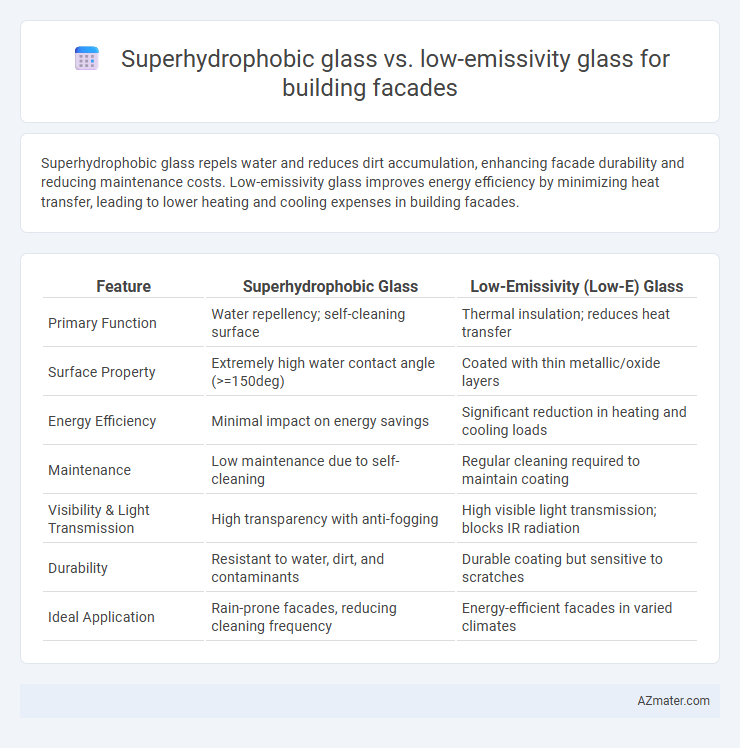Superhydrophobic glass repels water and reduces dirt accumulation, enhancing facade durability and reducing maintenance costs. Low-emissivity glass improves energy efficiency by minimizing heat transfer, leading to lower heating and cooling expenses in building facades.
Table of Comparison
| Feature | Superhydrophobic Glass | Low-Emissivity (Low-E) Glass |
|---|---|---|
| Primary Function | Water repellency; self-cleaning surface | Thermal insulation; reduces heat transfer |
| Surface Property | Extremely high water contact angle (>=150deg) | Coated with thin metallic/oxide layers |
| Energy Efficiency | Minimal impact on energy savings | Significant reduction in heating and cooling loads |
| Maintenance | Low maintenance due to self-cleaning | Regular cleaning required to maintain coating |
| Visibility & Light Transmission | High transparency with anti-fogging | High visible light transmission; blocks IR radiation |
| Durability | Resistant to water, dirt, and contaminants | Durable coating but sensitive to scratches |
| Ideal Application | Rain-prone facades, reducing cleaning frequency | Energy-efficient facades in varied climates |
Introduction to Advanced Facade Glazing Technologies
Superhydrophobic glass and low-emissivity (Low-E) glass represent cutting-edge advancements in building facade glazing technologies, each enhancing energy efficiency and durability. Superhydrophobic glass features nano-coatings that repel water and dirt, reducing maintenance and improving transparency over time. Low-E glass incorporates thin metallic layers that selectively reflect infrared radiation, significantly reducing heat transfer and improving thermal insulation in building envelopes.
What is Superhydrophobic Glass?
Superhydrophobic glass features a nanoscale textured coating that repels water, causing droplets to bead and roll off its surface, which enhances self-cleaning and reduces maintenance requirements for building facades. This glass type improves durability by preventing water-induced damage and inhibits dirt accumulation, maintaining clarity and aesthetic appeal. Unlike low-emissivity (Low-E) glass, which primarily reduces heat transfer and improves energy efficiency, superhydrophobic glass focuses on water repellency and surface cleanliness, making it ideal for facades exposed to rain and pollution.
Understanding Low-Emissivity (Low-E) Glass
Low-emissivity (Low-E) glass features microscopically thin metallic coatings that significantly reduce infrared and ultraviolet light transmission while maintaining visible light transparency, enhancing energy efficiency in building facades. This type of glass minimizes heat transfer, thereby reducing heating and cooling costs by reflecting interior temperatures back inside during winter and blocking solar heat in summer. Unlike superhydrophobic glass, which primarily offers water repellency and self-cleaning properties, Low-E glass focuses on thermal performance and building energy conservation.
Key Performance Differences: Water Resistance vs Thermal Control
Superhydrophobic glass exhibits exceptional water resistance by creating a surface that repels water droplets, minimizing moisture accumulation and reducing cleaning frequency on building facades. Low-emissivity (Low-E) glass, on the other hand, primarily enhances thermal control by reflecting infrared radiation, thereby improving energy efficiency through reduced heat transfer. While superhydrophobic glass excels in maintaining facade cleanliness and durability against weather elements, Low-E glass significantly contributes to indoor temperature regulation and energy savings.
Energy Efficiency Comparison in Building Applications
Superhydrophobic glass enhances energy efficiency in building facades by repelling water and dirt, reducing maintenance and ensuring consistent solar heat gain control, while low-emissivity (Low-E) glass minimizes thermal radiation transfer, significantly lowering heating and cooling energy consumption. Low-E glass typically achieves higher energy performance through superior insulation properties, reflected in U-values as low as 0.20 W/m2K, compared to conventional glass, whereas superhydrophobic coatings primarily support energy efficiency by maintaining surface clarity and performance over time. Combining superhydrophobic treatments with Low-E glass can optimize energy efficiency by preserving insulating properties and reducing the need for cleaning, leading to sustained thermal comfort and reduced operational costs in building applications.
Durability and Maintenance Requirements
Superhydrophobic glass offers superior durability by repelling water, dirt, and contaminants, significantly reducing the frequency of cleaning and maintenance for building facades. Low-emissivity (Low-E) glass enhances energy efficiency by minimizing heat transfer but may require more regular cleaning to maintain its performance and aesthetic clarity. While both types improve facade longevity, superhydrophobic coatings directly contribute to easier maintenance and sustained durability under harsh weather conditions.
Visual Clarity and Light Transmittance
Superhydrophobic glass offers exceptional water repellency with minimal impact on visual clarity, ensuring clear and unobstructed views for building facades. Low-emissivity (Low-E) glass enhances energy efficiency by reducing infrared heat transfer while maintaining high visible light transmittance, typically around 70-80%. The key difference lies in Low-E glass prioritizing thermal performance with slight light filtering, whereas superhydrophobic glass primarily maintains transparency and clarity through self-cleaning properties.
Climate Suitability for Each Glass Type
Superhydrophobic glass excels in humid and rainy climates by repelling water and reducing surface contamination, which maintains facade clarity and minimizes maintenance. Low-emissivity (Low-E) glass is ideal for cold and temperate regions, as its coating improves thermal insulation by reflecting infrared heat, enhancing energy efficiency and indoor comfort. Each glass type optimizes building facade performance based on specific climate demands, with superhydrophobic glass focused on moisture management and Low-E glass on thermal regulation.
Cost-Benefit Analysis for Facade Installation
Superhydrophobic glass significantly reduces maintenance costs by repelling water and dirt, thereby minimizing cleaning frequency, which is economically advantageous for building facades in harsh weather conditions. Low-emissivity (Low-e) glass offers superior energy savings through enhanced thermal insulation, reducing heating and cooling expenses over time despite higher initial installation costs. The cost-benefit analysis favors superhydrophobic glass for maintenance efficiency, while Low-e glass provides long-term financial benefits through energy conservation on facade installations.
Choosing the Right Glass for Sustainable Architecture
Superhydrophobic glass offers superior water repellency and self-cleaning properties, reducing maintenance costs and enhancing facade durability in sustainable building designs. Low-emissivity glass significantly improves energy efficiency by minimizing heat transfer, thereby reducing heating and cooling demands and lowering greenhouse gas emissions. Selecting the right glass depends on the building's climatic conditions and sustainability goals, with low-emissivity glass excelling in thermal performance and superhydrophobic glass enhancing facade longevity and environmental resilience.

Infographic: Superhydrophobic glass vs Low-emissivity glass for Building facade
 azmater.com
azmater.com